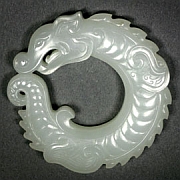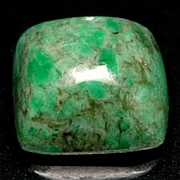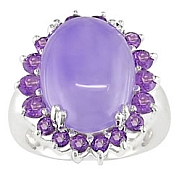Jade is a possession to be Description The terms jade and nephrite came to be used interchangeably until, in 1863, a French chemist discovered that jade was actually made of two distinct minerals. With this discovery, the terms jadeite and nephrite were reserved to distinguish the two different mineral varieties of jade, and the word jade was left as a general term to refer to both jadeite and nephrite. Nephrite Nephrite is the most common variety of jade and occurs naturally all over the world, with the oldest known source being the Xinjiang Province in China. Nephrite ranges in color from creamy white to deep olive green or brown. Jadeite Jadeite is more valuable than nephrite and is found mainly in Myanmar (Burma) and Guatemala. Jadeite ranges in color from white to yellow, reddish brown, green, lavender, grey, and black. A bright translucent green type of jadeite called Imperial Jade is most highly valued, but a type of mottled bright white and deep green jadeite called Moss in Snow is also desirable. History & Folklore Stone Age Jade No stone is tougher than jade. In the Stone Age, jade was known as the “axe stone” and was used to make knives and weapons. As metals came to replace jade as a material used to make weapons, jade took on a more symbolic significance. Maori Jade In early times, the Maori people of New Zealand carved weapons and ornaments from native jade, a tradition that continues to the present day. When Captain Cook arrived to New Zealand in 1769, he found the native Maori people using tools made from nephrite jade. They had not discovered copper or iron, and had never developed beyond Stone Age technology. The Maori believed that their gods inhabited jade. Special jade carvings called tiki, believed to grant protection and fertility, were passed on for many generations. A man married a woman when he put his family tiki around her neck. The Five Virtues of Chinese Jade In China jade has for centuries been finely carved and highly valued for its brilliant polish, compact hardness, and pure color. The Chinese called jade yü, using a calligraphic character that looked like three strands of beads, meaning "virtue, beauty, and rarity." Jade culture influenced every aspect of ancient Chinese society. The term “jade face” meant beauty and “jade heart” meant integrity. In addition to beauty and integrity, a wise man wrote of the five virtues of jade: Jade is beauty in stone with five virtues: Jade was considered the essence and strength of mountains. Men and women wore breastplates and amulets made of jade to protect against evil. Bodies of great and wealthy men were buried with special jade accessories to prevent decomposition and help attain immortality. Egyptian Jade Ancient Egyptians knew of jade and believed that it represented love and harmony. Roman Jade: Stone of the Kidneys The ancient Romans believed that jade soothed inflamed kidneys and referred to the stone as lapis nephriticus, meaning “stone of the kidneys.” Thus in Europe and along Italian trade routes, jade was commonly referred to as nephrite. Columbian Jade: Stone of the Loins In Pre-Columbian Central America jade was valued more highly than gold and was thought to be a gift from heaven. Like the ancient Romans, native Central Americans also believed that jade cured kidney ailments. When Spanish conquistadors arrived they referred to this miraculous green stone as piedra hijada, meaning “stone of the loins.” Gradually this Spanish phrase evolved to the term jade. Symbolism Hour: 9:00 pm Wedding anniversary, traditional: 12th Zodiac: Virgo US States: Canadian Province: Countries: China, New Zealand and Turkestan |
|




 jade bracelet
jade bracelet
